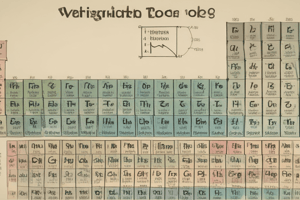Podcast
Questions and Answers
What is the primary organizing principle of the periodic table?
What is the primary organizing principle of the periodic table?
- Atomic mass
- Electron configuration
- Atomic number and electron configuration (correct)
- Recurring chemical properties
Which of the following periodic trends exhibits a decrease from left to right and an increase from top to bottom?
Which of the following periodic trends exhibits a decrease from left to right and an increase from top to bottom?
- Atomic radius (correct)
- Electronegativity
- Ionization energy
- None of the above
What is the characteristic of elements in the f-block of the periodic table?
What is the characteristic of elements in the f-block of the periodic table?
- They are less reactive and lose two electrons to form a +2 ion
- They are unreactive and have a full outer energy level
- They are a group of inner transition metals (correct)
- They are highly reactive and lose one electron to form a +1 ion
Which of the following groups of elements is characterized by being highly reactive and gaining one electron to form a -1 ion?
Which of the following groups of elements is characterized by being highly reactive and gaining one electron to form a -1 ion?
What is the characteristic of metalloids in the periodic table?
What is the characteristic of metalloids in the periodic table?
What is the main difference between metals and nonmetals in the periodic table?
What is the main difference between metals and nonmetals in the periodic table?
Flashcards are hidden until you start studying
Study Notes
Periodic Table Overview
- The periodic table is a tabular arrangement of elements, organized by their atomic number (number of protons in the nucleus), electron configuration, and recurring chemical properties.
- It is a powerful tool for chemists, physicists, and other scientists to classify and compare elements.
Periodic Table Structure
- The periodic table is divided into:
- Horizontal rows: Periods (1-7)
- Vertical columns: Groups (1-18)
- Two main categories: Metals (left and center) and Nonmetals (right)
- Elements are arranged in order of increasing atomic number (Z) from left to right and top to bottom.
Periodic Trends
- Atomic radius: Decreases from left to right and increases from top to bottom
- Electronegativity: Increases from left to right and decreases from top to bottom
- Ionization energy: Increases from left to right and decreases from top to bottom
- Electronegativity and ionization energy are related to the element's position in the periodic table
Periodic Table Blocks
- s-block: First two columns (alkali metals and alkaline earth metals)
- p-block: Columns 13-18 (main group elements)
- d-block: Columns 3-12 (transition metals)
- f-block: Lanthanides and actinides (bottom-left corner)
Families of Elements
- Alkali metals (Group 1): Highly reactive, lose one electron to form a +1 ion
- Alkaline earth metals (Group 2): Less reactive, lose two electrons to form a +2 ion
- Halogens (Group 17): Highly reactive, gain one electron to form a -1 ion
- Noble gases (Group 18): Unreactive, full outer energy level
Metals, Nonmetals, and Metalloids
- Metals: Typically shiny, malleable, and good conductors of electricity
- Nonmetals: Typically dull, brittle, and poor conductors of electricity
- Metalloids: Intermediate properties, often semiconductors (e.g., silicon, germanium)
Studying That Suits You
Use AI to generate personalized quizzes and flashcards to suit your learning preferences.




